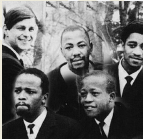 Like the rest of the world, I have been thinking about Nelson Mandela. I remember, must’ve been early 1980s, joining the 24-hour protest outside the South African Embassy in London, as well as boycotting South African goods, and British companies that traded there during apartheid. In particular I’ve been thinking about the relation between South African music and politics, and anti-apartheid campaigning and the important place and power of popular music, of jazz music in it. In Circular Breathing: The Cultural Politics of Jazz in Britain, there is lot about the musical, cultural and political impact of the South African musicians who came to London in the 1960s. Here is an extract, focussed on what they were escaping.
Like the rest of the world, I have been thinking about Nelson Mandela. I remember, must’ve been early 1980s, joining the 24-hour protest outside the South African Embassy in London, as well as boycotting South African goods, and British companies that traded there during apartheid. In particular I’ve been thinking about the relation between South African music and politics, and anti-apartheid campaigning and the important place and power of popular music, of jazz music in it. In Circular Breathing: The Cultural Politics of Jazz in Britain, there is lot about the musical, cultural and political impact of the South African musicians who came to London in the 1960s. Here is an extract, focussed on what they were escaping.
Also below is a video of Louis Moholo and Barbara Pukwana talking about their experiences of exile. And here, from LondonJazz, is a really good piece by Gwen Ansell about Mandela and musics of protest. And here also is Mike Fowler’s really interesting website dedicated to the Blue Notes, jazzers from South Africa.
___________________________________________________________________________________________________
… Apparently regardless of the extent to which they were as individuals ideologically articulate or politically active, by virtue of the music they played, their preferred cultural expression alone, South African jazz musicians were positioned politically, in opposition to the state. For white pianist Chris McGregor, playing in a mixed race band in Cape Town in the late 1950s—simply because they were ‘the best musicians I could find’—‘was already a quasi-political orientation’ on the part of all the musicians involved.
As a music student though, McGregor had been directly politicised by the authorities’ proposals to restrict access to the university for black students in 1957. Combined with the call for equal democratic rights articulated in the Freedom Charter of 1955 by the likes of Nelson Mandela, white and black jazz musicians began to play together for demonstrating crowds, education and dances in the townships, as well as at the limited bohemian white cultural spaces still available. Drummer Louis Moholo recalls some of the absurdities of musicians’ experiences of playing and socialising together in a multiracial band under apartheid, one more twist on minstrelsy, or Leonard Feather’s ‘white curtain’ closed again:
sometimes Chris McGregor would have to play behind a curtain, and vice versa, I would have to play behind a curtain if we got hired by some white cats. And Chris McGregor used to come to this place where we would drink some beer, in the Zulu quarters, but white people were not allowed in here; Chris would paint his face with black polish to come in there.
McGregor, Moholo, and saxophonist Dudu Pukwana looked to jazz to move beyond the increasingly strict apartheid structure of racial classification and oppression that defined their whiteness and blackness. With the epiphany of Duke Ellington and his big bands, McGregor stated simply that he ‘heard in him [Ellington] a certain solution to the problem of black traditions in a white world’. Primarily this involved the invention of a social community—elsewhere he would talk of his big bands as the creation of ‘my own village’—a repertoire of joyous music based on African traditions, and the Ellingtonian generosity of offering in the written arrangements the style and a space to best meet the individual voice of the soloist.
In a country imposing a serious and violent racialised social classification—symbolised most shockingly at Sharpeville on March 21 1960 when 69 protestors against the pass laws were killed by the police (many shot in the back), and nearly 200 injured—such multiracial grouping, cultural celebration and sensitivity could only be political. Micropolitically, when band rehearsals were subsequently raided by police, it was essential to clear up the teacups, because socialising between blacks and whites was no longer permitted.
At the same time, when a small group began to form around one of the clusters of musicians in Johannesburg and they called themselves the Blue Notes, even the band’s name was a double coding: on the one hand it clearly signalled the music of black American jazz, on the other the very word blue was intended to camouflage the colour issue. The young white South African pianist Manfred Mann was himself then exploring jazz in Johannesburg, and being educated in the complex etiquette of apartheid-dominated multiracial relations.
When I shook hands with Lewis Nkosi in the street we were both very, very conscious of everyone looking at us. The simplest human action was a contrived gesture. On another occasion the brilliant saxophonist Kippie Moeketsi came to my house, I was 18 years old, now why would he do that? It was an enormous privilege for me, but my stepmother made him come into our house through the back door. It was a terribly shaming experience…: Kippie himself was so used to this kind of thing, he handled with a dignified resignation. In rehearsals it was even very difficult to argue with a black musician. So although music was a sort of space we could carve out, it was fraught with difficulty.
